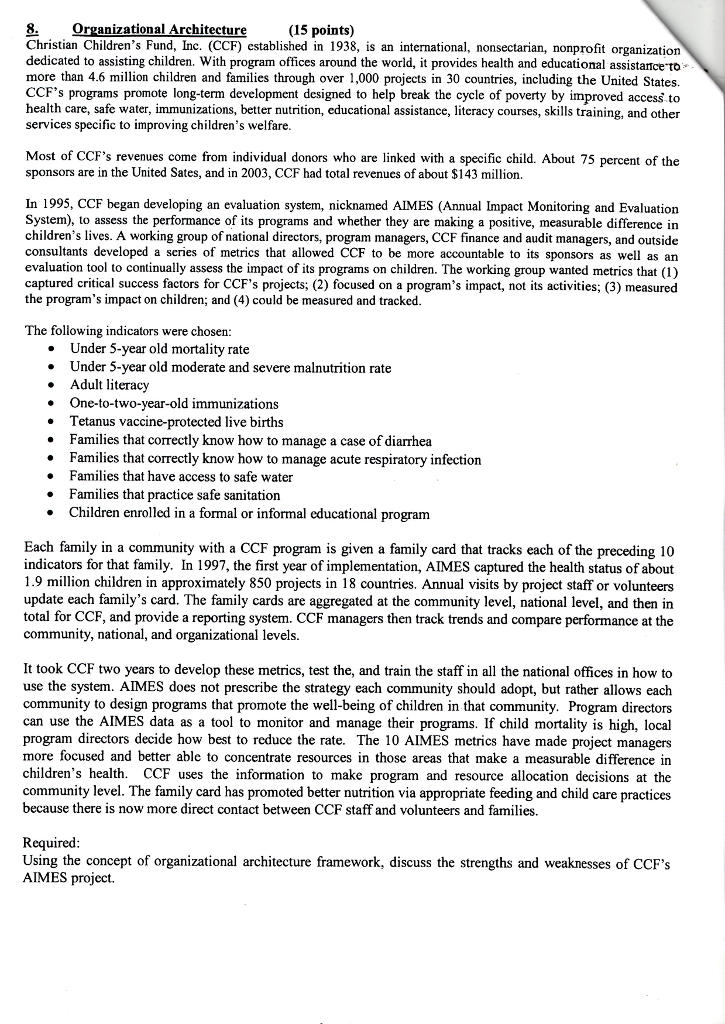

Organizational Architecture (15 points) Christian Children's Fund, Inc. (CCF) established in 1938, is an international, nonsectarian, nonprofit organization dedicated to assisting children. With program offices around the world, it provides health and educational assistance-to more than 4.6 mi on children and families through over 1,000 projects in 30 countries cluding the United States CCF's programs promote long-term development designed to help break the cycle of poverty by improved access to health care, safe water, immunizations, better nutrition, educational assistance, literacy courses, skills training and other services specific to improving children welfare Most of CCF's revenues come from individual donors who are nked with a specific child. About 75 percent of the sponsors are in the United Sates, and in 2003, CCF had total revenues of about $143 m In 1995, CCF began developing an evaluation system, nicknamed AIMES (Annual Impact Monitoring and Evaluation System), to assess the performance of its programs and whether they are making a positive, measurable difference in children's lives. A working group of national directors, program managers, ccF finance and audit managers, and outside consultants developed a series of metrics that allowed CCF to be more accountable to its sponsors as well as an evaluation tool to continually assess the impact of its programs on children. The working group wanted metrics that (1) captured critical success factors for CCF's projects; (2) focused on a program's impact, not its activities; (3) measured the program's impact on children; and (4) could be measured and tracked The following indicators were chosen Under 5-year old mortality rate Under 5-year old moderate and severe malnutrition rate Adult literacy One-to-two-year-old immunizations Tetanus vaccine-protected live births Families that correctly know how to manage a case of diarrhe Families that correctly know how to manage acute respiratory infection Families that have access to safe water Families that practice safe sanitation Children enrolled in a formal or informal educational program Each family in a community with a CCF program is given a family card that tracks each of the preceding 10 ndicators for that family. In 1997, the first year of implementation, AIMEs captured the health status of about 1.9 million children in approximately 850 projects in 18 countries. Annual visits by proj staff or volunteers update each family's card. The family cards are aggregated at the community level, national level, and then in total for CCF, and provide a reporting system. CCF managers then track trends and compare performance at the ommunity, national, and organizational levels It took CCF two years to develop these metrics, test the, and train the staff in all the national offices in how to use the system. AIMES does not prescribe the strategy each community should adopt, but rather allows each community to design programs that promote the well-being of children in that community. Program directors can use the AIMES data as a too o monitor and manage their programs. If child mortality is high, local program directors decide how best to reduce the rate. The 10 AIMES metrics have made project managers more focused and better able to concentrate resources in those areas that make a measurable difference in children's health CCF uses the information to make program and resource allocation decisions at the community level. The family card has promoted better nutrition via appropriate feeding and child care practices because there is now more direct contact between CCF staff and volunteers and famili Required Using the concept of organizational architecture framework, discuss the strengths and weaknesses of CCF's AIMES project








